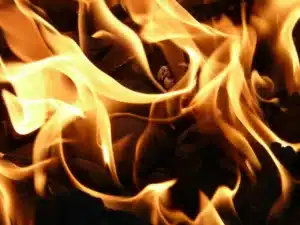February is usually one of the coldest months in the mid-Atlantic region, which means increased fireplace use for many families. And if you’ve been slacking on chimney sweeping, you are especially at risk of chimney fires. Chimney fires are dangerous because they cause the chimney to get very hot, which may lead to chimney damage, as well as cause the fire to spread. Our Maryland chimney cleaning specialists are happy to offer some tips to help you know what to do in case of a chimney fire.
Recognizing a Chimney Fire
Many minor chimney fires go unnoticed, which is dangerous. You should be familiar with how your fireplace normally operates, so that you can tell when something seems off. Also, never leave a fire unattended for a long time—the sooner you can catch a chimney fire, the better your chances are for minimal damage. Be on the lookout for the following signs of a chimney fire:
- Loud cracking or popping noises
- Black flakes and ash flying from the chimney
- Thick and dense smoke
- Odd and more potent burning smell
- Flames coming out of the chimney
- Something dripping into the fire from inside the chimney
Watch this demonstration by a fire department showing what a chimney fire looks like from the roof:
Step 1: Use the Fire Extinguisher
Every household should have a working fire extinguisher. If all signs point to a chimney fire, grab the extinguisher and direct it at the fire in the firebox first to put it out. Then direct it up the chimney to extinguish any fire that is burning inside. Keep going until you think the fire is out or until you stop seeing flames and black smoke coming out of the chimney.
Step 2: Call 911
If you have someone else in the house, have them call 911 while you are working the fire extinguisher. Even if you manage to put the chimney fire out, you would still want the firefighters to come out and double-check everything. It’s hard to see up the chimney, and you shouldn’t put your head there anyway in case hot ashes are dripping down. The only sure way to check is from the top of the chimney, which firefighters will do for you.
Step 3: Contact a Professional Chimney Sweep
The most likely reason for your chimney fire is creosote buildup. Creosote is a residue composed of unburnt gasses that collect inside the chimney. Creosote is black and can even be glossy from heat, lining the walls of your chimney like tar. Creosote is also flammable and when enough of it builds up, it can cause a chimney fire.
Obviously, your chimney needs cleaning, which is one of the reasons you should call a professional chimney sweep. But the most important reason is to inspect your chimney and make sure it wasn’t damaged during the fire. If it was really cold outside, or if you or firefighters used cold water to put out the fire, your chimney can crack due to drastic temperature changes. Make sure the sweep you hire is certified by the Chimney Safety Institute of America (CSIA)!
Contact CSIA-certified Town and Country Chimney Service today for chimney inspection and cleaning in Maryland.

